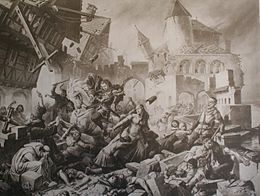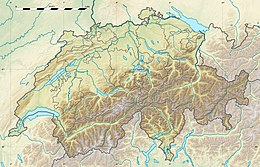1356 Basel earthquake
 Basel earthquake as envisioned byKarl Jauslin | |
| Local date | 18 October 1356 |
|---|---|
| Local time | 22:00 |
| Magnitude | 6.0–7.1Mw |
| Epicenter | nearBasel 47°30′N7°36′E/ 47.5°N 7.6°E |
| Max.intensity | MSK-64 IX (Destructive)–MSK-64 X (Devastating) |
| Casualties | 1,000 |

The1356 Basel earthquakeis the most significantseismological eventto have occurred inCentral Europeinrecorded history[1]and had amoment magnitudein the range of 6.0–7.1.[2]This earthquake, which occurred on 18 October 1356, is also known as theSankt-Lukas-Tag Erdbeben[3](English: Earthquake of Saint Luke), as 18 October is thefeast dayof SaintLuke the Evangelist.
Earthquake
[edit]After aforeshockbetween 19:00 and 20:00 local time, the main earthquake struck at around 22:00, and numerousaftershocksfollowed through that night.[4]Baselexperienced a second, very violent shock in the middle of the night. The town within the ramparts was destroyed by a fire when torches and candles falling to the floor set the wooden houses ablaze. The number of deaths within the town of Basel is estimated at 300. All major churches and castles within a 30 km (19 mi) radius of Basel were destroyed.[5]
The seismic crisis lasted a year. The modeling of the macroseismic data[5]suggests that the earthquake's source had an east–west orientation, a direction corresponding with the overlapping faults on theJura Front.[6]On the other hand, recentpaleoseismicstudies attribute the cause of this earthquake to anormal fault,oriented NNE-SSW and south of the town.[7]The significant magnitude of the event suggests a possible extension of this fault under the town.[8]
Location
[edit]Due to the limited records of the event, a variety ofepicentershave been proposed for the earthquake. Some of the proposed locations includefaultsbeneath theJura Mountainsor along the Basel-Reinachescarpment.[1]Another study placed the epicenter 10 km (6.2 mi) south of Basel.[9]
Intensity
[edit]The earthquake was felt as far away asZürich,Konstanz,and even inÎle-de-France.The maximum intensity registered on theMedvedev–Sponheuer–Karnik scalewas IX–X (Destructive–Devastating). The macroseismic map was established on the basis of damage reported by the region's 30 to 40 castles.[5][10]
From this macroseismic data, various studies have been conducted to estimate themoment magnitudeof the earthquake, which have resulted in various values of 6.2 (BRGM 1998);[2][5]6.0 (GEO-TER 2002);[2]6.9 (SED 2004) with a follow-up report suggesting a range of between 6.7 and 7.1;[2]6.6 (GFZ 2006);[2]and a major Swiss study by 21 European experts, with American involvement, in which four sub-groups estimated values of 6.9, 6.9, 6.5 to 6.9, and 6.5 ± 0.5 (PEGASOS 2002–2004).[2]There are also different opinions about whichfaultswere involved.[2]
Damage
[edit]Theearthquakedestroyed the city ofBasel,Switzerland, near the southern end of theUpper Rhine Graben,and caused much destruction in a vast region extending fromParistoPrague.[1]Though major earthquakes are common at the seismically active edges of tectonic plates in Turkey, Greece, and Italy,intraplate earthquakesare rare events in Central Europe. According to theSwiss Seismological Service,of more than 10,000 earthquakes in Switzerland over the past 800 years, only half a dozen of them have registered more than 6.0 on theRichter scale.[11]
See also
[edit] Switzerland portal
Switzerland portal- List of earthquakes in Switzerland
- Fessenheim Nuclear Power Plant
- Induced seismicity in Basel
- List of historical earthquakes
References
[edit]- ^abc"1356 Basel Earthquake: A 650-Year Retrospective"(PDF).Risk Management Solutions. 2006. Archived fromthe original(PDF)on 29 February 2012.Retrieved7 January2015.
The most damaging intraplate earthquake known to have occurred in central Europe
- ^abcdefgCentrale Nucléaire de Fessenheim: appréciation du risque sismiqueArchivedJuly 20, 2011, at theWayback MachineRÉSONANCE Ingénieurs-Conseils SA, published 2007-09-05, pages 12, 13
- ^"Das Erdbeben von 1356"(in German). Altbasel.ch. 24 October 2006.
- ^Von Waltenkofen K. (1357). Alphabetum Narrationum.
- ^abcdLambert, J.; Winter, T.; Dewez, T. J. B.; Sabourault, P. (2005), "New hypotheses on the maximum damage area of the 1356 Basel earthquake (Switzerland)",Quaternary Science Reviews,24(3–4): 381–399,Bibcode:2005QSRv...24..381L,doi:10.1016/j.quascirev.2004.02.019
- ^Meyer, B., Lacassin, R., Brulhet, J., Mouroux, B., 1994. "The Basel 1356 earthquake: which fault produced it?"Terra Nova6,54–63.
- ^Meghraoui, M. (2001). "Active Normal Faulting in the Upper Rhine Graben and Paleoseismic Identification of the 1356 Basel Earthquake".Science.293(5537): 2070–2073.doi:10.1126/science.1010618.ISSN0036-8075.JSTOR3084555.PMID11557888.S2CID34852180.
- ^Ferry, M.; Meghraoui, M.; Delouis, B.; Giardini, D. (2005)."Evidence for Holocene palaeoseismicity along the Basel—Reinach active normal fault (Switzerland): a seismic source for the 1356 earthquake in the Upper Rhine graben".Geophysical Journal International.160(2): 554–572.Bibcode:2005GeoJI.160..554F.doi:10.1111/j.1365-246X.2005.02404.x.hdl:20.500.11850/33737.
- ^Fäh, D; Gisler, M.; Jaggi, B.; Kästli, P.; Lutz, T.; Masciadri, V.; Matt, C.; Mayer-Rosa, D.; Rippmann, D.; Schwarz-Zanetti, G.; Tauber, J.; Wenk, T (July 2009)."The 1356 Basel earthquake: an interdisciplinary revision".Geophysical Journal International.178(1): 351–374.Bibcode:2009GeoJI.178..351F.doi:10.1111/j.1365-246X.2009.04130.x.hdl:20.500.11850/21256.
- ^D. Mayer-Rosa and B. Cadiot (1979). "A review of the 1356 Basel earthquake: basic data",Tectonophysics,53,pp. 325–333.
- ^Bradley, Simon (18 October 2006)."Switzerland prepares for seismic calamity".SwissInfo.Retrieved19 October2020.
Further reading
[edit]- Becker, Arnfried (17 May 2023). "Rockfalls triggered by the Basle earthquake on October 18, 1356".Jahresberichte und Mitteilungen des Oberrheinischen Geologischen Vereins.105:257–283.doi:10.1127/jmogv/105/0011.ISSN0078-2947.S2CID259059278.
External links
[edit]- Catholic Encyclopedia articleon the Diocese of Basel makes mentions the earthquake
- Das Grosse Beben von Basel im Jahr 1356
- Critical description of the earthquake and its consequences(in German)
- Preparing a seismic hazard model for Switzerland: The view from PEGASOS Expert Group 3

